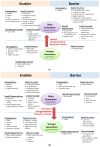Scoping Review: Intergenerational Resource Transfer and Possible Enabling Factors
- PMID: 33121044
- PMCID: PMC7662476
- DOI: 10.3390/ijerph17217868
Scoping Review: Intergenerational Resource Transfer and Possible Enabling Factors
Abstract
We explore the intergenerational pattern of resource transfer and possible associated factors. A scoping review was conducted of quantitative, peer-reviewed, English-language studies related to intergenerational transfer or interaction. We searched AgeLine, PsycINFO, Social Work Abstracts, and Sociological Abstracts for articles published between Jane 2008 and December 2018. Seventy-five studies from 25 countries met the inclusion criteria. The scoping review categorised resource transfers into three types: financial, instrumental, and emotional support. Using an intergenerational solidarity framework, factors associated with intergenerational transfer were placed in four categories: (1) demographic factors (e.g., age, gender, marital status, education, and ethno-cultural background); (2) needs and opportunities factors, including health, financial resources, and employment status; (3) family structures, namely, family composition, family relationship, and earlier family events; and (4) cultural-contextual structures, including state policies and social norms. Those factors were connected to the direction of resource transfer between generations. Downward transfers from senior to junior generations occur more frequently than upward transfers in many developed countries. Women dominate instrumental transfers, perhaps influenced by traditional gender roles. Overall, the pattern of resource transfer between generations is shown, and the impact of social norms and social policy on intergenerational transfers is highlighted. Policymakers should recognise the complicated interplay of each factor with different cultural contexts. The findings could inform policies that strengthen intergenerational solidarity and support.
Keywords: healthcare policy; intergenerational relationships; social capital.
Conflict of interest statement
We have no conflict of interest to declare.
Figures



References
-
- Ghazi-Tabatabaei M., Karimi Z. Socio-demographic, Economic and Structural Correlates of Intergenerational Support of the Elderly in Iran. Ageing Int. 2011;36:428–444. doi: 10.1007/s12126-011-9127-y. - DOI
-
- World Health Organisation Ageing and Health. [(accessed on 31 December 2019)]; Available online: http://who.int/news-room/fact-sheets/detail/ageing-and-health.
-
- Lin J.P., Yi C.C. A comparative analysis of intergenerational relations in East Asia. Int. Sociol. 2013;28:297–315. doi: 10.1177/0268580913485261. - DOI
Publication types
MeSH terms
LinkOut - more resources
Full Text Sources
Miscellaneous

